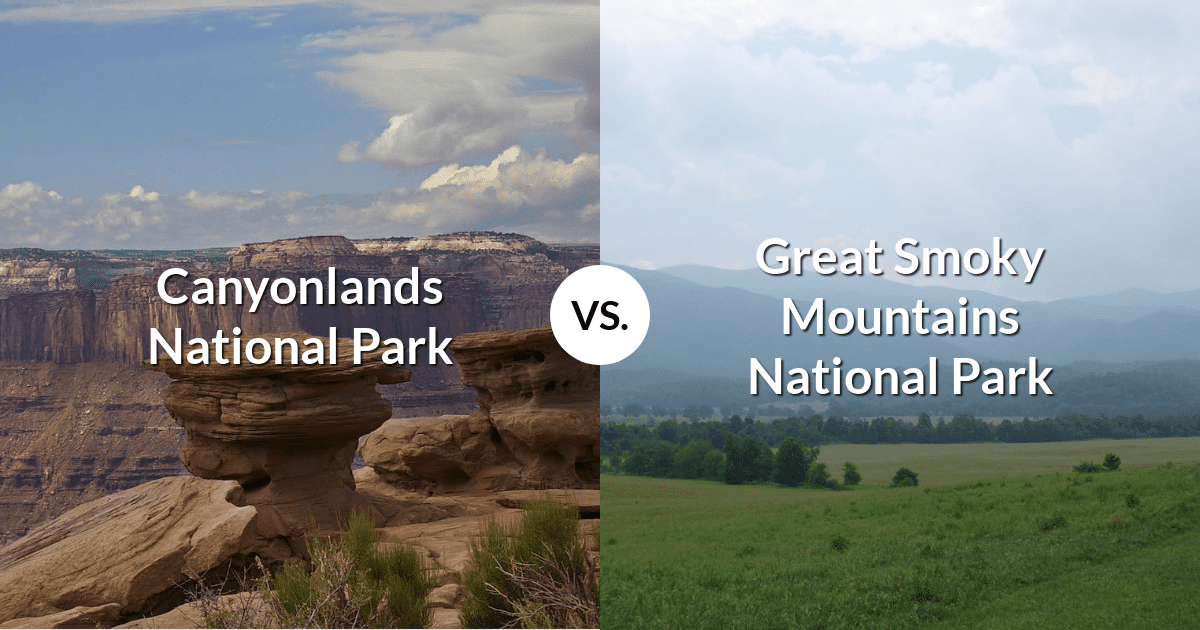Jake Cain is an entrepreneur and writer from Cincinnati, Ohio. He spends his free time driving around the country in his late 90’s conversion van, affectionately known as the “Monster Van” with his wife and 3 boys.
Canyonlands National Park and Great Smoky Mountains National Park are two of the most beloved national parks in the United States, but they couldn’t be more different. One is a desert oasis, where towering rock formations and deep canyons offer an otherworldly landscape. The other is a lush mountain paradise, where misty peaks and cascading waterfalls set the stage for a magical adventure. Both parks offer endless opportunities for hiking, camping, and sightseeing, but each one has its own unique character and charm that will leave visitors in awe. Imagine standing on the edge of a 1,000-foot drop and taking in the breathtaking views of Canyonlands, or being surrounded by the wildflowers and the melody of birds in Great Smoky Mountains. These are two parks that you don’t want to miss and are sure to provide a unique and unforgettable experience.
Hiking Trails in Canyonlands National Park and Great Smoky Mountains National Park
Canyonlands National Park and Great Smoky Mountains National Park are both home to a diverse array of hiking trails that vary in difficulty.
Canyonlands National Park, located in Utah, offers a wide range of hiking trails that vary in difficulty. Some of the easiest hikes in the park include the “Mesa Arch Trail” and “Upheaval Dome Trail”, which offer spectacular views of the park’s canyons and rock formations. The park also has several backpacking trails that are more challenging and require overnight camping, such as the “Needles District Backpacking Trail” and “The Maze District Backpacking Trail.”
Great Smoky Mountains National Park, located in Tennessee and North Carolina, offers a wide range of hiking trails that vary in difficulty. Some of the easiest hikes in the park include the “Cades Cove Loop Trail” and “Laurel Falls Trail” which offer scenic views of the park’s mountains and valleys. The park also has several backpacking trails that are more challenging and require overnight camping, such as the “Chimney Tops Trail” and “Mount LeConte via Alum Cave Trail.”
Both parks offer a range of trails that vary in difficulty, from easy nature walks to strenuous backpacking trails. Both also have great views of the park’s canyons, rock formations, mountains, and valleys that are worth visiting. The best time to hike in Canyonlands National Park is during the cooler months (spring, fall) while in Great Smoky Mountains National Park the best time is during the summer and early fall. It’s recommended to check the park’s website for trail conditions and closures before planning a hike.
Most Popular Hiking Trails in Canyonlands National Park
| Name | Length | Elevation | Type | Difficulty | Visitor Ratings |
|---|---|---|---|---|---|
| Mesa Arch Trail | 965.604 | 18.8976 | Easy | loop | 4.5 |
| Grand View Point Trail | 2896.812 | 52.7304 | Easy | out and back | 4.5 |
| Chesler Park Loop Trail | 18668.344 | 589.788 | Moderate | loop | 5 |
| False Kiva Trail | 3057.746 | 136.8552 | Moderate | out and back | 4.5 |
| Upheaval Dome via Crater View Trail | 2414.01 | 91.7448 | Moderate | out and back | 4 |
| Aztec Butte Trail | 2092.142 | 66.7512 | Moderate | out and back | 4.5 |
| Druid Arch Trail | 15288.73 | 418.7952 | Moderate | out and back | 4.5 |
| Shafer Trail | 30899.328 | 949.7568 | Moderate | point to point | 4.5 |
| White Rim Overlook Trail | 2896.812 | 48.768 | Easy | out and back | 4.5 |
| Syncline Loop | 13840.324 | 496.824 | Very Hard | loop | 4.5 |
Most Popular Hiking Trails in Great Smoky Mountains National Park
| Name | Length | Elevation | Type | Difficulty | Visitor Ratings |
|---|---|---|---|---|---|
| Alum Cave Trail to Mount LeConte | 17219.938 | 916.8384 | Hard | out and back | 5 |
| Chimney Tops Trail | 5793.624 | 392.8872 | Hard | out and back | 4.5 |
| Rainbow Falls Trail | 8851.37 | 503.8344 | Moderate | out and back | 4.5 |
| Grotto Falls Trail | 4184.284 | 162.7632 | Moderate | out and back | 4.5 |
| Laurel Falls Trail | 3862.416 | 120.7008 | Easy | out and back | 4 |
| Abrams Falls Trail | 7885.766 | 191.7192 | Moderate | out and back | 4.5 |
| Clingmans Dome Observation Tower Trail | 1931.208 | 100.8888 | Easy | out and back | 4.5 |
| Charlies Bunion via Appalachian Trail | 13840.324 | 603.8088 | Moderate | out and back | 4.5 |
| Ramsey Cascades Trail | 13035.654 | 677.8752 | Hard | out and back | 4.5 |
| Peregrine Peak via Alum Cave Bluffs Trail | 6759.228 | 322.7832 | Moderate | out and back | 5 |
Wildlife in Canyonlands National Park and Great Smoky Mountains National Park
Canyonlands National Park and Great Smoky Mountains National Park have different types of wildlife. At Canyonlands National Park, you can spot animals such as bighorn sheep, desert tortoise, and pronghorn. The park is also home to several species of birds, including golden eagles and peregrine falcons. The park also has a variety of plants, including Joshua trees and cacti. On the other hand, Great Smoky Mountains National Park is home to a wide variety of wildlife such as black bears, white-tailed deer, elk, wild turkey, and over 200 species of birds. The park is also home to a diverse array of plants, including wildflowers, rhododendrons, and hemlocks. Visitors to Great Smoky Mountains National Park may also spot rare species such as the Hellbender salamander and the Indiana bat.
Below are lists of the most commonly spotted wildlife at Canyonlands National Park and Great Smoky Mountains National Park. However, you can see a full list of wildlife at each national park here.
Birds
| Canyonlands National Park | Great Smoky Mountains National Park |
|---|---|
| Peregrine Falcon | Peregrine Falcon |
| Northern Harrier | Northern Harrier |
| Sharp-Shinned Hawk | Sharp-Shinned Hawk |
| Osprey | Osprey |
| Tree Swallow | Tree Swallow |
| Mallard | Mallard |
| Canada Goose | Canada Goose |
| Lincoln’s Sparrow | Lincoln’s Sparrow |
| Ruby-Crowned Kinglet | Ruby-Crowned Kinglet |
| American Robin | American Robin |
| Great Horned Owl | Great Horned Owl |
| Red-Tailed Hawk | Red-Tailed Hawk |
| Northern Flicker | Northern Flicker |
| Merlin | Merlin |
| Barn Swallow | Barn Swallow |
| Savannah Sparrow | Savannah Sparrow |
| Great Blue Heron | Great Blue Heron |
| Hermit Thrush | Hermit Thrush |
| American Kestrel | American Kestrel |
| Bald Eagle | Bald Eagle |
| Song Sparrow | Song Sparrow |
| European Starling | European Starling |
| Northern Pintail | Northern Pintail |
| American Wigeon | American Wigeon |
| Green-Winged Teal | Green-Winged Teal |
Mammals
| Canyonlands National Park | Great Smoky Mountains National Park |
|---|---|
| Coyote | Coyote |
| American Beaver | American Beaver |
| Muskrat | Muskrat |
| Big Brown Bat | Big Brown Bat |
| Bobcat | Bobcat |
| Striped Skunk | Striped Skunk |
| Little Brown Bat | Little Brown Bat |
| Deer Mouse | Deer Mouse |
| Raccoon | Raccoon |
| Black Bear | Black Bear |
| Porcupine | Porcupine |
| Silver-Haired Bat | Silver-Haired Bat |
| Hoary Bat | Hoary Bat |
| Red Fox | Red Fox |
| Long-Tailed Weasel | Long-Tailed Weasel |
| House Mouse | House Mouse |
| Mountain Lion | Panther (Mountain Lion) |
| American Mink | Mink |
| Mule Deer | Gray Fox |
| Common Gray Fox | Gray Wolf |
| Long-Legged Myotis | Snowshoe Hare |
| Long-Eared Myotis | River Otter |
| American Badger | Masked Shrew |
| Ermine | Water Shrew |
| California Myotis | Red Squirrel |
Fish
| Canyonlands National Park | Great Smoky Mountains National Park |
|---|---|
| Rainbow Trout | Rainbow Trout |
| Brown Trout | Brook Trout |
| Largemouth Bass | Brown Trout |
| Green Sunfish | Largemouth Bass |
| Bluegill | Green Sunfish |
| Fathead Minnow | Bluegill |
| Common Carp | Common Carp |
| Northern Pike | Longnose Dace |
| Speckled Dace | Yellow Bullhead |
| Yellow Bullhead | Channel Catfish |
| Channel Catfish | Black Crappie |
| Kokanee Salmon | Black Bullhead |
| Black Crappie | Mosquitofish |
| Black Bullhead | Creek Chub |
| Mosquitofish | Goldfish |
| Smallmouth Bass | Smallmouth Bass |
Reptiles
| Canyonlands National Park | Great Smoky Mountains National Park |
|---|---|
| Gophersnake | |
| Terrestrial Gartersnake | |
| Eastern Racer | |
| Prairie Rattlesnake | |
| Common Sagebrush Lizard | |
| Greater Short-Horned Lizard | |
| Side-Blotched Lizard | |
| Common Kingsnake | |
| Nightsnake | |
| Long-Nosed Leopard Lizard | |
| Striped Whipsnake | |
| Smith’s Black-Headed Snake | |
| Tree Lizard | |
| Western Whiptail | |
| Eastern Collared Lizard | |
| Desert Spiny Lizard |
Amphibians
| Canyonlands National Park | Great Smoky Mountains National Park |
|---|---|
| Northern Leopard Frog | Northern Leopard Frog |
| Tiger Salamander | American Bullfrog |
| American Bullfrog | Wood Frog |
| Woodhouse’s Toad | |
| Red-Spotted Toad | |
| Canyon Treefrog |
Insects
| Canyonlands National Park | Great Smoky Mountains National Park |
|---|---|
| Orange Sulphur | |
| Painted Lady | |
| Monarch | |
| American Painted Lady | |
| Red Admiral | |
| Mourning Cloak | |
| Cabbage White | |
| Silvery Blue | |
| Common Checkered Skipper | |
| Common Sulphur | |
| Honey Bee | |
| Variegated Fritillary | |
| Buckeye | |
| Commom Wood Nymph | |
| Gray Hairstreak |
Beautiful Landscapes in Canyonlands National Park and Great Smoky Mountains National Park
Canyonlands National Park is known for its breathtaking desert landscapes and towering rock formations. The park is divided into three districts: Island in the Sky, The Needles, and The Maze. The Island in the Sky district offers some of the most iconic views of the park, including the famous Mesa Arch, which frames a picturesque view of the canyon below. The district also includes several overlooks such as Grand View Point and Green River Overlook, which offer panoramic views of the park’s vast landscapes. The Needles district offers a different experience with its striking red rock formations and deep canyons. It is also known for its many hiking trails, such as the Chesler Park Loop and the Joint Trail, which take visitors through the heart of the district’s rock spires and formations. The Maze district is considered the most remote and rugged area of the park, where visitors can explore the challenging landscape of deep canyons, natural arches and rock spires.
Great Smoky Mountains National Park is known for its beautiful mountain landscapes and diverse range of ecosystems. The park is home to the highest peak in the eastern United States, Clingmans Dome, which offers a 360-degree view of the surrounding mountains. The park also features an array of waterfalls, like Grotto, Laurel, and Ramsey Cascades, that can be accessed via a short hike. Cades Cove is a popular destination, a valley surrounded by mountains, which offers a glimpse of the park’s rich history and culture. Visitors can also see abundant wildlife and wildflowers in season. The park also has a diverse range of hiking trails, from easy to strenuous, from the Alum Cave Bluffs trail to the strenuous hike to Mount LeConte.
Both parks are home to a vast array of natural wonders, each park offers a unique experience and a chance to explore the beauty of nature in different ways.
Things To-Do and Activities in Canyonlands National Park and Great Smoky Mountains National Park
Canyonlands National Park and Great Smoky Mountains National Park are both popular national parks with a variety of activities to enjoy.
At Canyonlands, popular activities include hiking, backpacking, and four-wheeling. The park’s rugged terrain offers many opportunities for backcountry exploration, and the park’s four districts provide a range of environments to explore, including canyons, mesas, and buttes. There are also many overlooks that offer stunning views of the park’s landscape.
At Great Smoky Mountains National Park, popular activities include hiking, camping, fishing, and wildlife viewing. The park has over 800 miles of hiking trails, including the famous Appalachian Trail. There are also many historic buildings and structures to explore, as well as opportunities to fish in the park’s streams and rivers. Wildlife viewing is also popular, with the park being home to a wide variety of animals including black bears, white-tailed deer, and elk.
Both parks offer a wide range of activities and landscapes that attract visitors from around the world. However, Canyonlands is more remote and rugged, with a more wilderness experience, while Great Smoky Mountains offers a more diverse range of activities, including historic and cultural experiences, making it a better choice for families or those seeking a more varied experience.
Best Time to Visit Canyonlands National Park and Great Smoky Mountains National Park
Canyonlands National Park and Great Smoky Mountains National Park have different seasonal weather patterns that can affect the best time of year to visit each park.
Canyonlands National Park, located in Utah, has a desert climate with hot summers and mild winters. The park’s temperature can reach above 100°F (38°C) during the summer months, making it quite uncomfortable for outdoor activities. The best time to visit the park is during the spring (April to June) and fall (September to November) when the temperature is mild and the wildflowers and fall foliage are in full bloom.
Great Smoky Mountains National Park, located in Tennessee and North Carolina, has a temperate climate with mild winters and warm summers. The park’s temperature can reach above 80°F (27°C) during the summer months. The best time to visit the park is during the summer (June to August) and early fall (September) when the wildflowers, rhododendrons, and fall foliage are in full bloom. In the winter, the park can have snow on the ground and the temperature may drop to freezing point. It is less crowded during the off-peak season, which can be a plus for visitors who want to avoid the crowds.
Both parks offer different experiences depending on the season. While Canyonlands National Park is better to visit in the cooler months, Great Smoky Mountains National Park is best to visit during the warmer months. It’s recommended to check the park’s website for trail conditions, closures and weather forecast before planning a trip.
Family Friendliness of Canyonlands National Park and Great Smoky Mountains National Park
Canyonlands National Park and Great Smoky Mountains National Park are both great options for families, but they offer different types of experiences.
Canyonlands National Park has a lot to offer families in terms of outdoor activities and education. The park has several well-maintained hiking trails that are suitable for families, such as the short and easy trail to Upheaval Dome, which offers great views and an interesting geological feature. The park also has a visitors center that offers educational programs and ranger-led activities, such as guided hikes and Junior Ranger programs.
Great Smoky Mountains National Park, on the other hand, is more family-friendly in terms of accessibility and variety of activities. The park has a wide range of hiking trails, from easy nature walks to strenuous mountain hikes. There are also many other activities such as fishing, horseback riding, and biking. The park also has a variety of campgrounds, picnic areas, and visitor centers that offer educational programs and ranger-led activities, such as guided hikes and Junior Ranger programs.
In conclusion, while Canyonlands National Park is great for families who want to explore the unique landscape and learn about geology and desert ecology, Great Smoky Mountains National Park is more family-friendly in terms of accessibility and variety of activities. Both parks are great options for families, but Great Smoky Mountains National Park may be a better choice if you’re traveling with children and looking for a more diverse range of activities.


